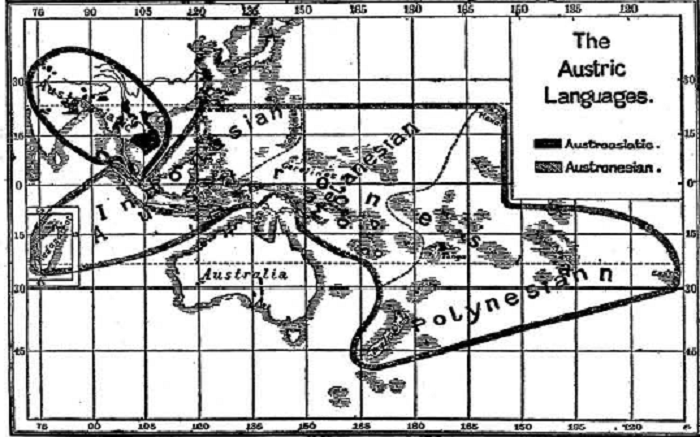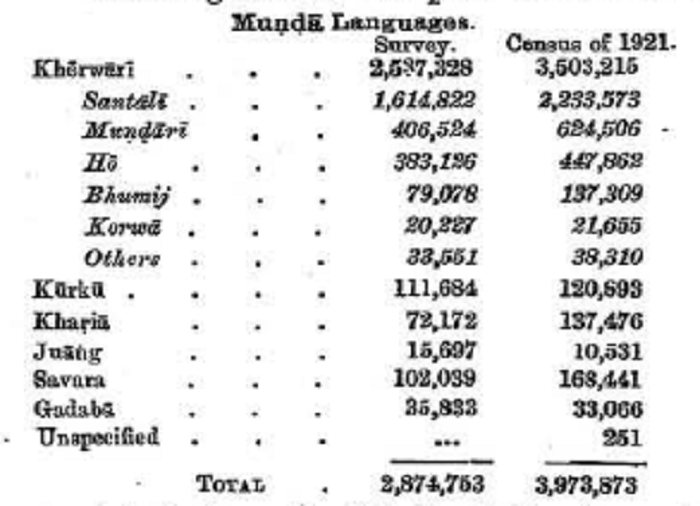The Austric family of Indian languages
(Created page with " {| class="wikitable" |- |colspan="0"|<div style="font-size:100%"> This article has been extracted from <br/> LINGUISTIC SURVEY OF INDIA<br/> SIR GEORGE ABRAHAM GRIERSON, K...") |
Revision as of 22:34, 15 March 2014
This article has been extracted from |
NOTE: While reading please keep in mind that all articles in this series have been scanned from a book. Invariably, some words get garbled during Optical Recognition. Besides, paragraphs get rearranged or omitted and/ or footnotes get inserted into the main text of the article, interrupting the flow. As an unfunded, volunteer effort we cannot do better than this.
While complete volumes of the LSI are available on at least 3 websites, Indpaedia wants readers to access the original chapters in the form in which they were listed by Mr Grierson, and with a minimum number of clicks and effort.
Readers who spot errors in this article and want to aid our efforts might like to copy the somewhat garbled text of this series of articles on an MS Word (or other word processing) file, correct the mistakes and send the corrected file to our Facebook page [Indpaedia.com]
Secondly, kindly ignore all references to page numbers, because they refer to the physical, printed book.
The Austric family
In the year 1906 there a.ppeared in Brunswick a little book by Pater W. Schmidt entitled ' ,Die Mou•Khmer-V6lker, ein Bindeglied zwischen Volkern Zentmlasieos und Austronesiens' which at once attracted the attention of students of language and of ethnology-. The -author's -researches into the languages known as MllD. Khmer, and KMsi had a.l~'" established. his reput&tion as a skilled a.nd. lIot the same time, as a. sobor philologist. and in this work new and far-reaching views, based on solid and wide learning. were enU:~ciated. These views up to the present time have not been seriously challenged. Pa.ter Schmidt here proved the eristenoe of a great family of languages hitherto not recognized, which, although the langti:ages composing it are spoken by a. comparatively small number of people. is spread over au "rea wider than that occupied by any other group of tongues. Its speakers are found scattered' over Nearer a.nd Further India.. and form the native popul!lotion of Indonesia.
Mel!lonesia, and Polynesia, including madagascar and New Zealand. It extends from Madagascar, off the coast of Africa, to Easter Island which is less than forty degrees from the COOBt of South America.. In the North, traces of it were discovered in Kaniiwar in the Panjab. a.nd it.~ sQuthern limit included Nelv Zealand. West, of Easter Island it covers the whole Paci6.c Ocean, except Australia. (including Tasmania) and a part of New Guinea..
'This' Austrie Family,' as he named it. he divided into two sub-fa~ilios. the' AustroNesian' a.nd the' Austro-Asiatic.' The former included the languages of Madagascar. Indoeesia, and the islands of the Pacific. while the latter included language!! scattered O\'l;)r Neare.r and Further India. The annexed map. based on that in Pater Schmidt's work. shows their respective localities.
The only Austro-Nesian languages politically connected. witb India. aU! Sal6n.spoken
by a tribe of sea--gipsies inhabiting the isllmds of the Mergui
8a.I8a. Arohipelago and the adjacent pa.rt.a of the Malay Penin6ulo.
and Malay spoken in the same locality". These languages consequently did not fall
The Aunstro-Asiatic sub-fa.m.ily is much more strongly represented. in India. There
is first the great Mon-Khmer Branch spoken in Further India.
of which we have three representatives in Burma, in tbe shape
of Mon, Bn ancient litera.ry llmguage now spoken in 'l'bat.on and Amherst. Bnd Palaung
the Sakei and the Semang. Like Khmer these are spoken outside the limit;., of Briti!:lh India.. Nieoooreae al80 belong. to this branch. and seems to form a connecting link between the M~41l languages and MOn.
None of the above languages fell within t he opera.tions of the Survey, but going north we come to Khlsi, 80 M6n-Khm~r la.nguage spoken. in the Khasi and Jaintia Hills of Assam. This W&8 fully dea.lt with in the Survey. It/lstandard dialect has been often dcscribed.audmoreover possesses a. small Iitera.ture with 'which it has been end0:Wed. by the local missionaries. Khiiai is more or less isolated a.like from its cousins of Burma and from those of India, und hM struck out on somewlmt independent lines a.part from MOil, Nicobarese, und MUQQ.ii, which are mutually more closely connected. than any of t hem is with Kha,si. With its three dia.lects of Lyng-ngam, Bynteng, and War, in addition to the standard form of
The resemblances in the vocabularies of Rbisl and of ~be dialects of tbe PUlalWgWa
group aettle the question. But the resemblance is not; only one of vocabulary. The
construction of the Mon and of the Khasl Iw.ntenoo b the same. The various
component parts are put in the saMe order, and the order of thought of the speakers is
thns shown to be the same. Like Mim and other members of t he bmncb, and unlike the
other Indo-Chinese ~guages by which it is surrounded., KhAsi has no tones.' On the other'
hand, it differs from the other Mon-Khmer languages in possessing the so-called articles,
which are wanting in other member8 of the branch. and in ha.ving grammatical gender.
Here we must leave the matter in the hands of the ethnologist<>. It will be interesting
to see if allY connexion of tribal customs can be tmced, and if the MOns or Palaungs
still retain surviva.ls of the matriarchal state of society which is so characteristic of the
Khiisls. The Palaungs . at any rate, trace their origin to a princess, and not to a
Prince.leaving Assam we pass to Central India. where we find the Munda languages


